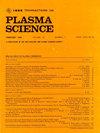Analysis of the Electron Distribution Function Inside of a LaB₆ Hollow Cathode
IF 1.3
4区 物理与天体物理
Q3 PHYSICS, FLUIDS & PLASMAS
引用次数: 0
Abstract
Langmuir probe measurements have been performed many times in hollow cathodes and remain one of the most commonly used diagnostic methods to determine electron temperature, density, and plasma potential. The objective of this project was to analyze which possible electron processes can also be determined using a single-wire Langmuir probe in combination with the Druyvesteyn electron energy distribution function (EEDF) method. The well-documented JPL NASA LaB6 hollow cathode using argon, without a heater and without an orifice, was chosen for this study. The probe tip was located at the backend of the plasma. The Druyvesteyn EEDF method resulted in three distinct electron population peaks, representing single ionization, secondary electron production due to ion bombardment of the low work function insert, and thermionic electron production. The electron temperature for almost all three peaks decreased slightly with increasing mass flow rate. The electron number density also decreased with mass flow rate; however, each population showed a different rate of decrease. The detection showed different populations for different locations in the upstream plasma sheath. The results of this investigation indicate that thermionic emission, secondary ion bombardment, ionization, and their associated electron extractions can be measured using the Druyvesteyn EEDF method.lab4600中空阴极内部电子分布函数分析
Langmuir探针测量已经在空心阴极中进行了多次,并且仍然是确定电子温度,密度和等离子体势的最常用诊断方法之一。该项目的目的是分析哪些可能的电子过程也可以使用单线Langmuir探针结合Druyvesteyn电子能量分布函数(EEDF)方法来确定。本研究选择了JPL NASA LaB6空心阴极,该阴极使用氩气,没有加热器,也没有孔。探针尖端位于等离子体的后端。Druyvesteyn EEDF方法产生了三个不同的电子居群峰,分别代表单电离、低功函数插入的离子轰击产生的二次电子和热离子电子的产生。随着质量流量的增加,几乎所有三个峰的电子温度都略有下降。电子数密度随质量流量的增大而减小;然而,每个种群的下降速度不同。在上游等离子鞘的不同位置检测到不同的种群。研究结果表明,用Druyvesteyn EEDF方法可以测量热离子发射、二次离子轰击、电离和它们相关的电子萃取。
本文章由计算机程序翻译,如有差异,请以英文原文为准。
求助全文
约1分钟内获得全文
求助全文
来源期刊

IEEE Transactions on Plasma Science
物理-物理:流体与等离子体
CiteScore
3.00
自引率
20.00%
发文量
538
审稿时长
3.8 months
期刊介绍:
The scope covers all aspects of the theory and application of plasma science. It includes the following areas: magnetohydrodynamics; thermionics and plasma diodes; basic plasma phenomena; gaseous electronics; microwave/plasma interaction; electron, ion, and plasma sources; space plasmas; intense electron and ion beams; laser-plasma interactions; plasma diagnostics; plasma chemistry and processing; solid-state plasmas; plasma heating; plasma for controlled fusion research; high energy density plasmas; industrial/commercial applications of plasma physics; plasma waves and instabilities; and high power microwave and submillimeter wave generation.
 求助内容:
求助内容: 应助结果提醒方式:
应助结果提醒方式:


